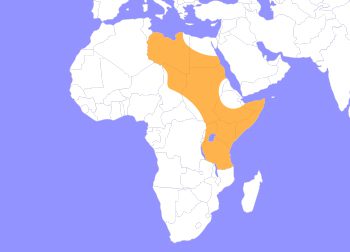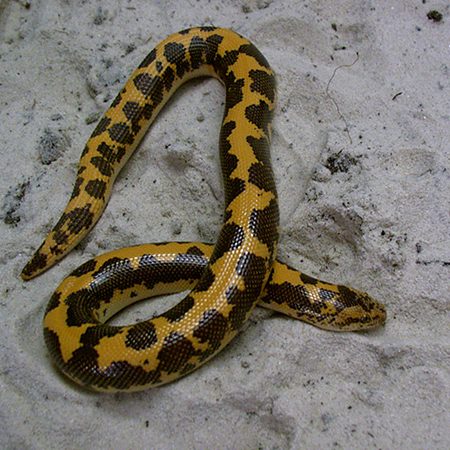Kenyan Sand Boa
Gongylophis colubrinus
Kenyan Sand Boas are small snakes that can be found in East Africa in semi-arid savannahs and rock outcroppings. They are known for their ability to burrow themselves under the sand to hide. They will spend most of their life there, or in other hidings spots beneath stones or in burrows. Their colors are designed for them to hide in a desert with their underbellies being a cream color and their backs being orange-brown with dark brown splotches. In order to breathe and see while under the sand, their nostrils and eyes are located on top of their heads.
Females are larger than males, being 2-3 ft in length, while males only reach to just over a foot long. Generally, they weigh 2 lbs or less and can live up to 15 years. In the wild, their colors are pretty standard, but in the pet trade many morphs have been bred. Colors now include albino, snow (white with brown), yellow, black, and many shades in between. Like other boas, the Sand Boa appears to give live birth (true pythons lay eggs). What is actually happening is that boas will form eggs inside their bodies, but the babies hatch while still in the female and then leave, giving it the appearance of a live birth.
Say Hello To Cub Creek's Sand Boa: Aladdin
Aladdin is our very secretive sand boa. He loves burrowing deep into his sand, only coming up to breathe, drink, or eat. He continues to grow and is almost a foot long! We got Aladdin back in December of 2014 and spends summers in the Creepy Crawly Room with our Tarantulas, Crested Geckos, and more!

Kenyan Sand Boas are endemic to Northern Africa, indigenous to Kenya, ranging to Somalia.
HABITAT -Native to the deserts of East Africa, not just limited to Kenya.
DIET -They will eat pests like mice, rats, and even insects, along with lizards or baby birds.
FUN FACT -Their tail has sharp scales that can be used for defense.
SOCIAL BEHAVIOR -They are solitary animals and very friendly with humans.
ACTIVITY -They are crepuscular to avoid the desert heat, only coming out at dawn and dusk.
PREDATORS -Desert monitor lizards have been known to prey on them.
SIZE -Females can be 2-3 ft while males are only about a foot long.
RELATIVES -They are related to other boas, such as the Ball Python or Colombian red tail.
CONSERVATION -They are not evaluated under the IUCN.
Cub Creek Animal Care Information
Housing - Being a sand boa, Aladdin is housed differently than the rest of our snakes. Instead, he lives in his own 10-gallon tank filled with sand for him to hide in and explore. A heat lamp is kept on the sand during the day to simulate his natural desert environment. He does not need much else to stay happy and is given access to fresh water every day.
Diet - Once a week, our snakes are fed frozen mice that are tailored to the snake’s size. Snakes have very slow metabolisms, so they do not need to be fed often to receive all of their necessary nutrients. Aladdin gets fed a pinky, which is a baby mouse.
Enrichment - Reptiles do not need a lot of enrichment beyond their various hides. Our campers give them plenty of stimulation by handling them and even occasionally bringing them outside on warmer days in the summer.


